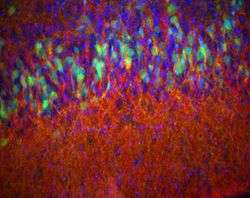Paralimbic cortex
| Paralimbic cortex | |
|---|---|
|
Piriform cortex from a 14-day-old mouse, stained for D2-eGFP (green), enkephalin (red) and DAPI (blue) to show nuclei. Epifluorescence. | |
| Details | |
| Latin | Cortex paralimbicus |
The paralimbic cortex is an area of three-layered cortex that includes the following regions: the piriform cortex, entorhinal cortex, the parahippocampal cortex on the medial surface of the temporal lobe, and the cingulate cortex just above the corpus callosum.[1][2]
The paralimbic cortex lies close to, and is directly connected with, the structures of the limbic system.[1](The prefix para meaning beside or adjacent to). The paralimbic cortex, also referred to as the mesocortex, or juxtallocortex, is interposed between the neocortex and the allocortex.[3]The paralimbic cortex provides a gradual transition from primary limbic regions, including the septal region, substantia innominata, and the amygdala nuclei, to higher neocortical regions.[4]
There are dense connections between the paralimbic cortex and core limbic structures, in particular the amygdala. The amygdaloid complex comprises both nuclear and cortical layers. These cortical features of the amygdala often extend into the paralimbic areas, blurring the boundaries between limbic and paralimbic regions.[5] Thus, these regions may collectively be termed the ‘paralimbic system’.
It is cytoarchitecturally defined: it has three layers, where layer 2,3 and 4 are merged, and is intermediate in form between the allocortex (less than six layers) and the neocortex (six distinct layers). It is found within the limbic system, representing the border between neocortical and allocortical parts.[6][7] It has been hypothesized that the cortex should be viewed as concentric rings of allocortex, mesocortex and isocortex.[8]
Functions
The paralimbic cortex serves as a transitional region between the neocortex and the allocortex incorporating a region of proisocortex, as a subdivision of the neocortex, and a region of periallocortex, as a subdivision of the allocortex.[9] It constitutes a group of interconnecting brain structures that are involved in the functions of emotion processing, goal setting, motivation and self-control.
See also
References
- 1 2 Kolb & Whishaw: Fundamentals of Human Neuropsychology, 2003.
- ↑ Mesulam, 2000 In: M.M. Mesulam, Editor, Principles of Behavioral and Cognitive Neurology (2nd ed.), Oxford University Press, New York (2000)
- ↑ mediLexicon: Definition: 'Juxtallocortex'. http://www.medilexicon.com/medicaldictionary.php?t=46602
- ↑ Mesulam, 2000 In: M.M. Mesulam, Editor, Principles of Behavioral and Cognitive Neurology (2nd ed.), Oxford University Press, New York (2000)
- ↑ Mesulam, 2000 In: M.M. Mesulam, Editor, Principles of Behavioral and Cognitive Neurology (2nd ed.), Oxford University Press, New York (2000)
- ↑ G. Avanzini, Anne Beaumanoir, Laura Mira, eds. Limbic Seizures in Children. John Libbey Eurotext, 2001, p. 13
- ↑ Almut Schuez, Robert Miller. Cortical Areas: Unity and Diversity. CRC Press, 13 Jul 2003, pp. 236-237.
- ↑ Reep R. Relationship between prefrontal and limbic cortex: a comparative anatomical review. Brain Behav Evol. 1984;25(1):5-80.
- ↑ http://www.braininfo.rprc.washington.edu. Missing or empty
|title=(help); External link in|website=(help);
